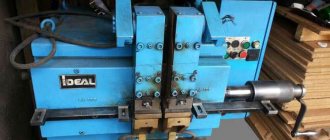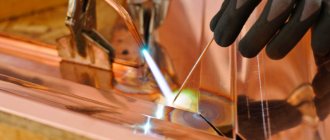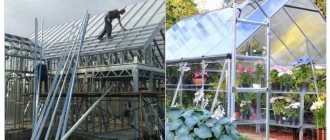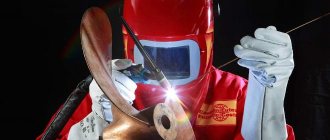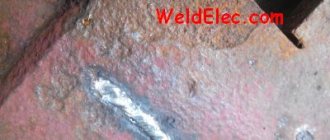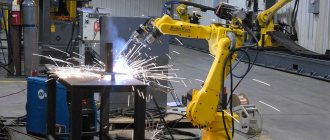Copper argon welding is in demand in various industries and the construction industry. This is due to the performance properties of the material, which has high corrosion resistance and an optimal ratio of strength and ductility. However, the welding process has a number of difficulties and requires skills.
Welding copper with argon
Material properties
To weld copper or copper-based alloys, it is necessary to perform high-quality heating of the structures. Thanks to excellent thermal conductivity, it is quite easy to ensure uniform temperature on the surface of the part and throughout the thickness of the material. However, obtaining a uniform, strong seam requires the use of certain skills.
Welding Features:
- with a significant increase in temperature, oxidation processes begin to occur in copper, as a result of which refractory phases of increased fragility are created, which negatively affects its strength and plastic properties;
- During cooling of the seam, significant shrinkage occurs, which can cause cracks;
- as a result of heating, the absorption of gases begins, increasing the likelihood of the formation of unevenness and cavities;
- welds at the junctions of copper with stainless steel and other metals have a high level of granularity associated with the heterogeneity of the materials, the connection becomes brittle and unreliable;
- due to high electrical conductivity, high currents are required on the welding machine, which makes household inverters unsuitable for welding work;
- Due to the high level of metal fluidity when heated, creating seams in a vertical or ceiling position is impossible.
Welding technology
Welding of copper parts is carried out in two ways:
- gas welding;
- argon welding.
For gas welding, you will need to use an acetylene cylinder and a torch. The quality of the seam depends entirely on the number of pores in the material, so before carrying out work it is necessary to forge the surface near the seam formation line.
To maintain combustion, a continuous supply of gas is required. The average consumption for welding structures more than 10 mm thick is 200 l/h. It is recommended to preheat massive parts so that the seam is strong and uniform.
Since copper has high thermal conductivity, it is important to ensure uniform cooling of structures. To do this, the structure should be covered on all sides with asbestos sheets, making a kind of protective screen.
In order to prevent the formation of oxides or shells during the welding process, it is allowed to increase the speed of movement of the torch along the seam, but the movement must be at a constant speed and without breaks. The location of the burner relative to the surface must be perpendicular.
For materials with a thickness of more than 3 mm, it is necessary to process the edges at an angle of 450. In order for the metal to better fill the joint, it is treated with an aqueous solution of nitric acid.
After completing the work, the seam must be forged at a temperature of +3000C, and also annealed at +5000C, then the parts must be cooled in water.
Argon arc welding is suitable for joining structures of any thickness, including large ones. Welding work is carried out by connecting direct polarity with direct current using a tungsten non-consumable electrode. The average temperature should be from +3000C to +4000C.
Before welding, you need to heat the arc on a plate of coal or graphite. Welding in ceiling, vertical or bottom positions is acceptable.
Copper gas welding
Welding technique
Welding in argon with a “forward angle” when releasing the electrode 5-7mm. The following are used as filler wire:
- deoxidized copper
- copper-nickel alloy MNZHKT-5-1-0.2-0.2
- bronze BrKMts 3-1, Br OTs 4-3
- special alloys with effective deoxidizers.
To increase the resistance of the weld metal against hot cracks, welding wires are used:
- BrAZhNMn 8.5-4-5-1.5
- BrMts AZHN 12-8-3-3
- M Mts 40
To prevent molten metal from getting to the end of the W-electrode, the filler wire is not inserted into the arc column, but is fed to the edge of the weld pool and slightly to the side
Selecting Electrodes
To obtain a high-quality weld, it is necessary to select an electrode according to the diameter, composition of the coating, and the characteristics of the composition of the workpiece material. The composition of the coating plays a protective role, as it prevents gases from entering the melt.
When welding copper with argon, coatings and protective coatings make it possible to create special films. The coating contains additives that improve the weld when the electrode rod material comes into contact with the metal of the structure. In this case, the seam is formed homogeneously and hardens evenly, at the same time the creation of brittle phases is eliminated.
Two types of electrodes are used:
- non-melting, based on synthetic graphite, electrical coal, as well as other materials with similar properties.
- melting, created on the basis of rods made of copper, cast iron, aluminum wire, on top of which a special coating is applied.
To understand which electrode to weld copper with, you need to focus on the color of the coating:
- red – for manual welding;
- blue – for refractory alloys;
- gray – for welding parts made of non-ferrous metals.
Welding copper with argon: features, choice of additive, preparation and process technology
Copper as a metal is a soft, fairly malleable material. It is characterized by a relatively simple processing process by smelting the ore into metal, which can be further processed. This property has led to the widespread use of copper products, however, it significantly complicates welding due to the physical and chemical properties of the properties.
Copper welding modes in argon
As with other types of materials being welded, welding modes should be selected based on the quality of the parts. Approximate mode options are based on the thickness of the metal being welded, the diameter of the electrodes, wires and result in certain current indicators, measured in amperes.
| Copper welding modes in argon | |||
| Thickness of welded parts, mm | Electrode diameter, mm | Filler wire diameter, mm | Current strength, A |
| Butt joints made by weight | |||
| 1,0 – 1,5 | 2 – 3 | 1,6 – 2,0 | 60 – 150 |
| 2,0 – 3,0 | 2 – 4 | 2,0 – 3,0 | 80 – 220 |
| 4,0 – 5,0 | 4 – 5 | 2,0 – 4,0 | 130 – 220 |
| 6,0 – 7,0 | 4 – 5 | 2,0 – 4,0 | 130 – 220 |
| 8,0 – 10,0 | 5 | 2,0 – 4,0 | 180 – 260 |
| Backed butt joints and corner joints | |||
| 1,0 – 1,5 | 2 – 3 | 1,6 – 2,0 | 70 – 160 |
| 2,0 – 3,0 | 2 – 4 | 2,0 – 3,0 | 120 – 220 |
| 4,0 – 5,0 | 4 – 5 | 2,0 – 4,0 | 190 – 260 |
| 6,0 – 7,0 | 5 | 2,0 – 4,0 | 230 – 290 |
| 8,0 – 10,0 | 5 | 2,0 – 4,0 | 280 – 330 |
| Argon consumption – 8-15 dm3/min. |
Each mode, however, must be selected in accordance with the specific welding conditions and tested on parts similar in material to those parts on which the main welding process will be performed.
Selection of filler materials
Filler materials used for welding copper parts must be selected based on data on the physical and chemical properties of copper or its alloys from which the parts or products are made.
When welding, you should pay attention to the brand of copper or alloy itself - it must be deoxidized or oxygen-free, since, otherwise, during the welding process the metal will boil in the weld pool, as a result of which the weld will be porous and fragile.
As a rod or wire, you should use materials that will avoid boiling of the material in the weld: you need to select a wire or rod that contains chemical elements in the alloy that allow you to displace oxygen from the weld pool area.
Approximate cost of copper wire on Yandex.market
The only non-consumable electrode is tungsten, at the end of which there should be a conical sharpening with a slight bluntness. This form will ensure stable burning of the arc during the welding process itself, which will make it possible to maintain the temperature level of the welding zone and will not allow the parts to quickly cool down until the weld is completed.
Approximate cost of tungsten electrodes on Yandex.market
If we talk about the shielding gas that is used during welding, then the choice depends on the welding conditions, including the spatial position of the joint. Argon is heavier than air, in particular oxygen, and it settles towards the ground under the influence of natural gravitational forces.
Approximate cost of argon cylinders of different volumes on Yandex.market
If it is necessary to make ceiling joints, then it will be necessary to replace argon with helium, which is lighter than air, but can also perform protective functions when performing welding work.
Copper argon arc welding technology
From a technological point of view, copper argon arc welding, like other types of welding, is divided into three stages:
- preparatory _ At this stage, it is necessary to clean the surfaces to be welded from oxides, contaminants, and degrease. After completing these works, you should check them for cleanliness and condition and, if necessary, clean them manually or using a power tool, and then repeat the process of removing oxides and degreasing;
- the actual welding stage;
- the final stage , at which the quality of the welded joint is checked after stripping of frozen drops of molten metal, as well as visual control of the quality of the seam for visible pores.
At the welding stage, the following steps should be performed:
- if we are talking about repairing any copper product, it is necessary to make a slot along the crack that has arisen so that the edges of such a slot extend beyond the crack . This will make it possible to avoid the appearance of new cracks outside the repaired area;
- the arc is ignited only in the edge section, which will avoid burns of the metal from which the entire product is made and will reduce the areas to be cleaned;
- the filler wire or rod must be guided in front of the torch so that it is evenly fed into the weld pool;
- the movements of the welding torch should be as smooth as possible and maintain a constant distance from the tungsten electrode to the weld pool;
- depending on the thickness of the parts to be welded, the torch can move along the seam being created in different ways : in a straight line if the thickness of the parts is small, or in a zigzag if the parts are thick. If transverse movements are made, this is fraught with an increase in the depth of penetration of the edges and changes in the formation of the weld seam;
- if thin-walled parts are welded, then in order to avoid metal burns, it is necessary to make short seams, and take time breaks between them to cool the metal;
- if the parts are assembled without a gap, it is possible to weld without using wire or rod . However, in this case, you should not overheat the metal in order to avoid the weld pool sagging inward;
- at the end of welding, it is necessary to withdraw the torch smoothly, lengthening the welding arc , which will reduce the weld crater;
- If the machine has a function for welding the weld crater, then it is possible to simplify the process of completing welding work;
- After welding is completed, it is necessary to maintain the supply of shielding gas for some time (up to thirty seconds) . This will keep the cooling seam in a cloud of gas protection and avoid the entry of ambient air products into the molten metal, which will preserve the quality of the seam.
( 1 rating, average 5 out of 5 )
Equipment
For argon arc welding you will need to use the following equipment:
- inverter device or transformer;
- one burner or a set, depending on the complexity of the work;
- protective equipment;
- gas cylinders;
- compensation devices for current regulation.
Argon welding can be performed manually or semi-automatically. The method is selected based on what welding work is planned to be carried out, its complexity, and technical requirements for the seam.
Material preparation, cleaning
Welding copper with argon can be carried out without thorough surface preparation; it is enough to clean it with an abrasive tool until it shines, and also degrease it. However, cleaning must be done thoroughly.
To weld structures with a thickness of 5-12 mm, it is necessary to cut off one-sided edges, and if more than 12 mm, cut off two-sided edges.
Cleaning before welding
Work at home
At home, welding of small parts is sometimes required, so for most cases, ordinary copper wires are suitable as electrodes. All stages of work are determined by copper welding technology:
- Clean the rod from surface layers of varnish, oxide, grease or other types of contaminants. It is recommended to use wires with a minimum amount of impurities in the composition.
- During the welding process, additives are used to act as a protective medium from metal contact with air.
- The burner is ignited, the additive is placed in front of the seam, then the electrode, and heating is carried out behind them. The torch movements should be in a spiral towards the formation of the seam.
When welding thick parts, it is recommended to melt the base metal of the structure, but on the basis of which the connection is formed. In this case, the seam is clean and neat. In this case, additives are not used.
In an argon environment, the quality of the seam is achieved with a vertical position of the seam and horizontal welding.
Welding of thin parts is carried out in a stepwise manner. The method consists of performing welding at certain intervals, and then welding the missing areas until a uniform and high-quality seam is obtained.
Setting up the device
To achieve the quality of the connecting seam, you need to carefully select the parameters of the welding machines. It is necessary to weld pure copper at direct current with tungsten electrodes in a protective argon atmosphere. It is recommended to weld alloys using alternating current.
Beginners or inexperienced welders are recommended to use welding machines that have a selection of standard welding programs available. This will reduce the number of defective parts and increase work efficiency.
Current settings are selected depending on the following criteria:
- metal thickness;
- electrode wire diameter;
- type and diameter of filler rod.
In addition to argon, it is permissible to use nitrogen, helium, and mixtures of protective gases. Argon is effective and therefore is used more often than other gas mixtures.
Welding difficulties
The high thermal conductivity of copper (6 times higher than that of iron) requires the use of a welding arc with increased thermal power and symmetrical heat removal from the welding zone. Recommended types of welded joints are butt joints and those with similar heat dissipation characteristics.
The high fluidity of copper (2-2.5 times higher than that of steel) complicates the welding of vertical and ceiling seams. It is possible only with minimal weld pool sizes and a short residence time of the metal in the liquid state. When welding butt joints in the lower position with guaranteed penetration, in order to avoid burn-through, it is necessary to use pads made of graphite, dry asbestos, flux pads, etc.
The active ability to absorb gases (oxygen and hydrogen) during melting, leading to weld porosity and hot cracks, requires reliable protection of the weld metal and welding materials from contamination with harmful impurities.
Due to the tendency of copper to oxidize with the formation of refractory oxides, it is necessary to use filler material with deoxidizing gels, the main ones being phosphorus, silicon and manganese.
The large coefficient of linear expansion of copper (1.5 times higher than that of steel) entails significant deformations and stresses, and the formation of hot cracks. They can be eliminated by preheating structures: copper up to 250-300°C, bronze up to 500-600°C
